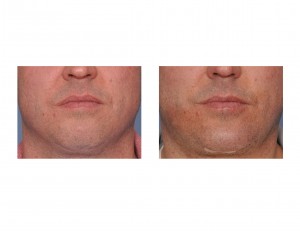Background: Chin augmentation is the original and the most common area of facial skeletal enhancement. As a projecting edge of bone that is fairly easy to access, placing a chin implant is understandably perceived as a very simple and near error-free facial implant procedure. Despite this commonly-held belief, however, chin implants do have problems and need to be revised, replaced, or even removed.
There are two common chin implant problems, malpositioning and implant selection. Malpositioning of a chin implant can occur in two different ways. Superior or upward migration of the implant usually occurs if it is placed from inside the mouth. While the intraoral approach avoids an external incision, its path of dissection provides an avenue for the implant to slide up along the bone afterwards. Lateral or wing malpositioning is actually the most common problem and is a result of the newer styles having thin and more floppy wing extensions which can easily fold onto themselves. Chin implants can also have size (undersized, oversized) and style (too wide, too narrow) problems which is a preoperative diagnosis and selection issue.




Case Highlights:
1) Chin augmentation requires proper placement of the implant on the bone. Intraoral chin augmentation is prone to superior implant migration and malpositioning.
2) Replacement of a highly positioned chin implant is best done from a submental approach with screw fixation.
3) In the male chin augmentation, consideration needs to be given to an implant design that provides more lateral fullness and extends back further towards the body of the mandible.
Dr. Barry Eppley
Indianapolis, Indiana



